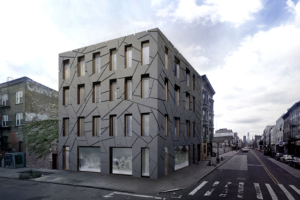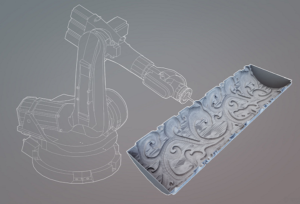New York Architecture Firm Uses 3D Printing to Create Beautiful Concrete Molds for Building Restoration
 Architecture and engineering firm EDG, based in New York, designs new buildings, renovations, and restoration projects. Now, the company is investigating the different capabilities that 3D printing can bring to its industry. Over the last five years, EDG has been researching the possible combination of concrete casting and 3D printing to create customizable molds.
Architecture and engineering firm EDG, based in New York, designs new buildings, renovations, and restoration projects. Now, the company is investigating the different capabilities that 3D printing can bring to its industry. Over the last five years, EDG has been researching the possible combination of concrete casting and 3D printing to create customizable molds.
John Meyer, the company’s Founding and Managing Partner, was inspired to look into applications for the technology during the first initial buzz about 3D printing in the architecture industry. Using a MakerBot Replicator Z18, Meyer and the rest of the EDG team, now coming in at 30 employees, began prototyping and researching.
Over its 12 years in business, the technology-driven firm has completed 2,650 projects, more than 300 of which took place last year. The company is skilled in layouts and building code, restoration, material science, structural engineering, and architectural design, among other things. In investigating 3D printing, the goal was to move past only using the technology to build small parts that were delicate and breakable, putting it to work with real world applications.
- Modern Ornamental
In focusing on something other than solid 3D printed parts, the company’s research team zeroed in on the possibility of using 3D printing to manufacture complex concrete molds. Once EDG figured out how to properly apply it, the implications of this decision grew. The company heard that 574 Fifth Avenue, a building from the 1940s featuring intricate ornamentation, was to be demolished, and turned the restoration project into a case study, which was, as The Architects Newspaper put it, “a perfect prompt for thinking of alternative ways to restore and maintain deteriorating ornamentation.”
“Building restoration is a specialized field, requiring extensive knowledge of historical construction techniques,” the EDG website reads. “From constant observation of failure, comes our design of repairs.
“Our staff has experience with all building construction types, allowing us to design practical, cost-effective repairs. We combine our expertise with the latest advances in technology to accurately identify the extent of existing damage without the guesswork. With construction costs often more than ten times our design fee, we always look to add value and save money, covering our fees on every project.”
EDG researched mold thicknesses and materials on a rooftop close to its office, and eventually landed on the proper combination of strength, material, and cost efficiency for the building. The 3D printed plastic form the company created is inlaid with a laser cut wire mesh, and stirrups help reinforce the cast. In addition, the company designed a simple plate connection system, which is formed into the 3D printed area for simple attachment to the building’s facade.
The company decided against using its MakerBot 3D printer for the final prototype, calling instead on voxeljet and its VX1000 3D printer to manufacture the casting molds, which were created in-house using Sika concrete.
While their research has opened up many positive implications for the future of historic preservation, it also has many possibilities for facade design and construction. EDG stated that designers can use 3D printing to mold and shape “building elements in unprecedented detail.”
The company is continuing on with its innovative 3D printing research, and already has two new projects that it’s working on. One of these is a multi-family project in Brooklyn, and together with the second project, will use the same original methodology, but “through a more contemporary lens.”
Meyer said, “This technique allows for more textures, finishes, flowing shapes, and unique patterning which you can only get when you’re not paying for a precast form.”
 Meyer and the rest of the EDG team are currently building their own customized 3D printer that will be better suited for the company’s material and size constraints. Additionally, the company is planning a design competition, where entrants come up with possible uses for their new technique on architectural facades. This will help open the process of facade design to designers who work in fields other than architecture.
Meyer and the rest of the EDG team are currently building their own customized 3D printer that will be better suited for the company’s material and size constraints. Additionally, the company is planning a design competition, where entrants come up with possible uses for their new technique on architectural facades. This will help open the process of facade design to designers who work in fields other than architecture.
Discuss this and other 3D printing topics at 3DPrintBoard.com or share your thoughts in the comments below.
[Images: EDG]
Subscribe to Our Email Newsletter
Stay up-to-date on all the latest news from the 3D printing industry and receive information and offers from third party vendors.
You May Also Like
Precision at the Microscale: UK Researchers Advance Medical Devices with BMF’s 3D Printing Tech
University of Nottingham researchers are using Boston Micro Fabrication‘s (BMF) 3D printing technology to develop medical devices that improve compatibility with human tissue. Funded by a UK grant, this project...
3D Printing Webinar and Event Roundup: April 21, 2024
It’s another busy week of webinars and events, starting with Hannover Messe in Germany and continuing with Metalcasting Congress, Chinaplas, TechBlick’s Innovation Festival, and more. Stratasys continues its advanced training...
3D Printing Webinar and Event Roundup: March 17, 2024
It’s another busy week of webinars and events, including SALMED 2024 and AM Forum in Berlin. Stratasys continues its in-person training and is offering two webinars, ASTM is holding a...
3D Printed Micro Antenna is 15% Smaller and 6X Lighter
Horizon Microtechnologies has achieved success in creating a high-frequency D-Band horn antenna through micro 3D printing. However, this achievement did not rely solely on 3D printing; it involved a combination...


































